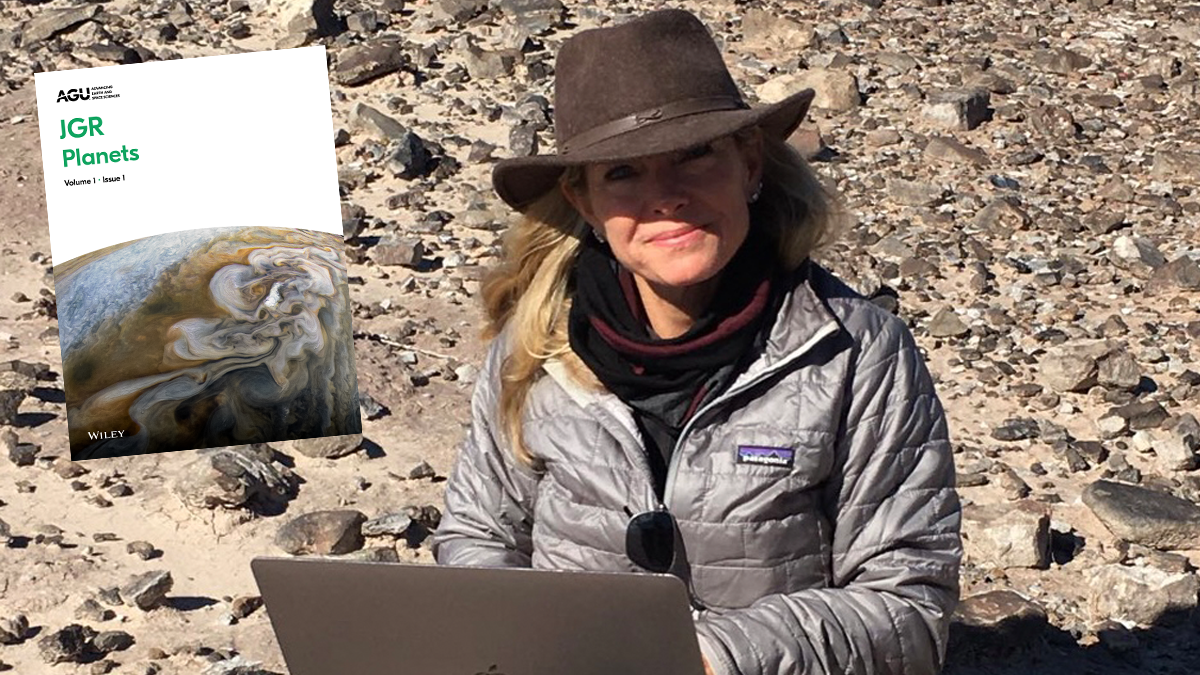Editors’ Vox is a blog from AGU’s Publications Department.
We are delighted to share that Amanda Hendrix has recently taken over as the Editor-in-Chief of JGR: Planets. We asked her some questions about her own research interests and vision for the journal.
What are your own areas of scientific interest?
I study moons and small bodies in the solar system. I am interested in understanding how we can use ultraviolet-visible spectroscopy to learn about the evolution of the surfaces of these worlds.
I study moons and small bodies in the solar system. I am interested in understanding how we can use ultraviolet-visible spectroscopy to learn about the evolution of the surfaces of these worlds.
How do icy surfaces, silicate-dominated and carbon-rich surfaces respond chemically and structurally to exposure to processes such as micrometeoroid bombardment and irradiation by solar wind or magnetospheric particles, and how are these changes manifested at UV and visible wavelengths? For instance, we can study water on the Moon as a result of solar wind and comet bombardment and assess transport of volatiles to the cold polar regions.
We also study low-albedo, carbonaceous asteroids to understand compositional variations that could reflect large-scale processes such as giant planet migration. At icy moons, we can understand impacts on surface alternation of plasma and dust bombardment, as well as looking for evidence of plume activity. Much of my research is based on data from missions such as Cassini, Lunar Reconnaissance Orbiter, Galileo, Hubble Space Telescope, and looking ahead to Europa Clipper.
What does it mean to you to serve as Editor-in-Chief of JGR: Planets?
AGU is at the forefront of open science initiatives which are so important in terms of making science results accessible and inclusive.
I’m very honored to serve as Editor-in-Chief at JGR: Planets. I’m a big fan of AGU’s journals because AGU is at the forefront of open science initiatives, which are so important in terms of making science results accessible and inclusive.
It’s also a treat for me to get a sneak peek into the exciting work that our colleagues are doing in the wide array of planetary topics that are covered in JGR: Planets. I am proud to do my part to make sure that each manuscript is handled fairly and expeditiously, and am so glad to serve the community in this capacity.
What makes JGR: Planets special?
One of the really neat things about JGR: Planets is that instead of “special issues,” we have “special collections,” which can be combined with other AGU journals. So, you can propose a special collection on some topic, and include papers in JGR: Planets and, say, JGR: Space Physics and Geophysical Research Letters. That allows the authors to write papers of different formats if they wish, and also can increase readership! We also make the extra effort to promote our authors by sharing an announcement of every single paper on social media. Also, lots of institutions have relationships with Wiley (our publisher) so that open access fees are removed or discounted. Check out the list here.
What are some of the challenges of leading this journal?
I’m proud that JGR: Planets has a very reasonable average turnaround time for getting authors a first decision.
Everyone is busy! I understand that the review and publication process can get held up at different stages due to people’s schedules. We’re all doing the best we can and I’m proud that JGR: Planets has a very reasonable average turnaround time for getting authors a first decision.
Also, I think that some authors are still getting used to the guidelines about open science. But really it is not too hard to put your data in a findable, citable repository and reference that in your Data Availability statement. I think it’s just a matter of getting used to that. In terms of software, I understand that some authors may not want to share every bit of code that they’ve spent years developing. I get that – but the key is to make sure that readers can understand the inputs so that results can be reproduced.
How do you plan to take the journal forward in the coming years?
I would like to continue the fantastic work of the previous editor, Laurent Montési, by continuing to expand the diversity of the editorial board and the topics covered in JGR: Planets. We’re bringing on some terrific new editors and associate editors to supplement our fantastic current set, and I look forward to working with our board to continue to provide the best possible level of service to our community in terms of fair and timely reviews and publication of the exciting research happening in the planetary science areas. We’re working on assembling some exciting special collections and reaching out to authors at conferences to help everyone understand the policies of JGR: Planets and increase awareness of the journal, particularly to newer members of the planetary community.
—Amanda Hendrix ([email protected]; ![]() 0000-0002-0435-8224), Planetary Science Institute, USA
0000-0002-0435-8224), Planetary Science Institute, USA
Learn more about the outgoing Editor-in-Chief, Laurent Montési.

